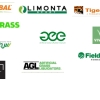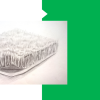The main parameters of artificial turf are:
grass weight(Dtex), grass height, density, gauge, stitches rate, backing material, base cloth, adhesive, width, roll length, etc.
Artificial turf is mainly distinguished from these parameters. But how shall we to understand the meaning of these parameters?
1. Grass height: the height of the artificial turf. Range of height: 1CM-6CM,
Common specifications are 1CM, 2CM, 2.5CM, 3CM, 3.5CM, 4CM, 5CM, 6CM.
The height of artificial turf used in general football field is above 4CM-6CM,
and the height of artificial turf used for leisure decoration landscaping is generally below 4CM. The height of artificial turf depends on the purpose of the field.
2. The synthetic turf weight (Dtex):
The pound weight of grass fiber is the unit of textile fiber Dtex, which is the gram weight of 10,000 meters of fiber.
Grass fibers range from thousands to tens of thousands. The heavier the weight is, the better the quality. The weight of football lawn and landscape lawn is 6000D-12000D, and the weight of grass for gateball, golf, tennis, running track, etc. ranges from 5000D to 10000D.
3. Turf gauge: Turf gauge is the distance between lawn rows, usually in inches, 1 inch=2.54cm.
The following are the usual line spacing of several common line spacing equipment: 3/4, 3/8, 3/16, 5/8, 1/2 inch, (for example, 3/4’’, that is, 3/4*2.54cm=1.905 cm; 5/8 stitch length, that is, 5/8*2.54cm=1.588cm)
4. Stitches rate: The number of needles is the number of needles per meter of tufting.
Calculating with 10 stitches/10cm, then 100 stitches per meter. For the same stitch length, the more stitches, the greater the density of the lawn. On the contrary, the sparser.
5. Density: Tufting density is an important indicator of artificial grass, which refers to the number of tufting needles per square meter.
Take the stitches rate of 20 stitches/10CM as an example, if it is 3/4 turf gauge (1.905cm), the number of rows per meter is 52.5 (number of rows = per meter/turf gauge; 100cm/1.905cm=52.5), and the number of stitches per meter is 200 , Then tufting density = number of rows * number of needles (52.5*200=10500); then 3/8, 3/16, 5/8, 5/16 and so on, 21000, 42000, 12600, 25200, etc.
6. Base cloth: as the name implies, the base cloth is the bottom of the lawn.
Generally, the base cloth includes PP, mesh base cloth, and composite base cloth. PP base: generally used for leisure grass; mesh base: glass, strong net Materials such as lattice fibers can increase the strength of the bottom and the binding force of grass fibers. The composite base fabric is tougher and the material cost is also higher.
7.Width: The width is the width of each roll of artificial turf. The finished product is 4 meters wide, which can be cut as required.
The standard 11-a-side football field is generally 4 meters wide, and if it is a 5-a-side field, it is generally 2 meters wide. Roll length: The roll length is the length of each roll of lawn. The length of each roll can be flexibly adjusted according to the paving requirements of the site. The roll length is 20 to 70 meters. If the 11-a-side football field is about 68 meters apart from the buffer zone on both sides, then the 70-meter roll length is just right. And so on.
Lemon Wang
Shanghai Gee Sports Industry Co.,Ltd
Web: www.geegrass.com
Tel: +86 (21) 57653537
Line Id: geegrass
Mob./Whats app: +86 189 1653 4027
Email:sales6@geegrass.com






